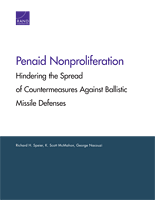| 来源类型 | Research Reports
|
| 规范类型 | 报告
|
| ISBN | 9780833081490
|
| 来源ID | RR-378-DTRA
|
| Penaid Nonproliferation: Hindering the Spread of Countermeasures Against Ballistic Missile Defenses |
| Richard H. Speier; K. Scott McMahon; George Nacouzi
|
| 发表日期 | 2014
|
| 出版年 | 2014
|
| 页码 | 78
|
| 语种 | 英语
|
| 结论 |
There Are Established Control Mechanisms to Prevent the Proliferation of Weapons of Mass Destruction- The eight classes of items in the Missile Technology Control Regime's (MTCR's) Category I are subject to the tightest export restrictions. The MTCR guidelines state that such exports, if they occur at all, must be "rare" and subject to strong provisions with respect to supplier responsibility.
- Category II items can be used to make Category I items, but they are dual-use. (That is, they have other purposes, such as a role in the functioning of peaceful satellites.) Category II exports are subject to greater flexibility but nevertheless require case-by-case export reviews and specific international procedures.
- The MTCR has well-developed procedures for coordinating export decisions among its members. In addition, the United States has legislation providing sanctions against domestic and foreign entities that contribute to missile proliferation.
Nineteen Classes of Technologies and Equipment Related to Ballistic Missile Countermeasures (Known as Penetration Aids, or Penaids) Are Likely Candidates for International Export Control- Penaid-related items appropriate for inclusion in Category I are missile-borne countermeasure subsystems and penaids designed to saturate, confuse, evade, or suppress missile defenses and designed or modified for rocket systems capable of delivering at least a 500 kg payload to a range of 300 km.
- There may be a reluctance to widen the strict restrictions of Category I to a large number of additional items. For that reason, it may be better to place certain items under the case-by-case review provisions of Category II.
- Other classes of penaid-related items are clearly dual-use and therefore conform to the provisions of Category II, requiring case-by-case review.
|
| 摘要 |
- The Missile Technology Control Regime (MTCR) should implement the tightest controls on three types of penetration aid (penaid)-related items: complete, integrated countermeasure subsystems; complete subsystems for missile defense test targets; and boost-glide vehicles.
- It should consider the tightest controls for ten lower-level subsystems that are specifically applicable to penaids, but it may be more realistic to perform a case-by-case review to maintain room for negotiation and avoid overloading the export-control framework. These items are as follows: canisters and dispensers; post-boost subsystems; replicas and decoys; electronic countermeasures; chaff, obscurants, and flares; reentry vehicle or decoy signature control mechanisms; plume signature control mechanisms; wake modification mechanisms; maneuvering subsystems; and submunitions.
- The MTCR should subject six classes of items to a case-by-case review rather than an assumption of export denial because they are clearly dual-use. That is, they have utility for other, nonpenaid applications, such as peaceful satellites. These items are as follows: multiple-object deployment capabilities, inflation and assembly items, hardening, attack warning sensors, fly-along sensors, and test facilities and equipment.
|
| 主题 | Arms Proliferation and Control
; Ballistic Missiles
; Global Security
; Missile Defense
; Weapons of Mass Destruction
|
| URL | https://www.rand.org/pubs/research_reports/RR378.html
|
| 来源智库 | RAND Corporation (United States)
|
| 资源类型 | 智库出版物
|
| 条目标识符 | http://119.78.100.153/handle/2XGU8XDN/107649
|
推荐引用方式
GB/T 7714 |
Richard H. Speier,K. Scott McMahon,George Nacouzi. Penaid Nonproliferation: Hindering the Spread of Countermeasures Against Ballistic Missile Defenses. 2014.
|
|
文件名:
|
1412866808846.gif
|
|
格式:
|
GIF
|

|
文件名:
|
RAND_RR378.pdf
|
|
格式:
|
Adobe PDF
|
此文件暂不支持浏览
除非特别说明,本系统中所有内容都受版权保护,并保留所有权利。